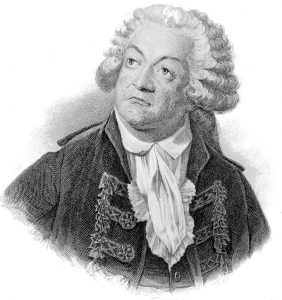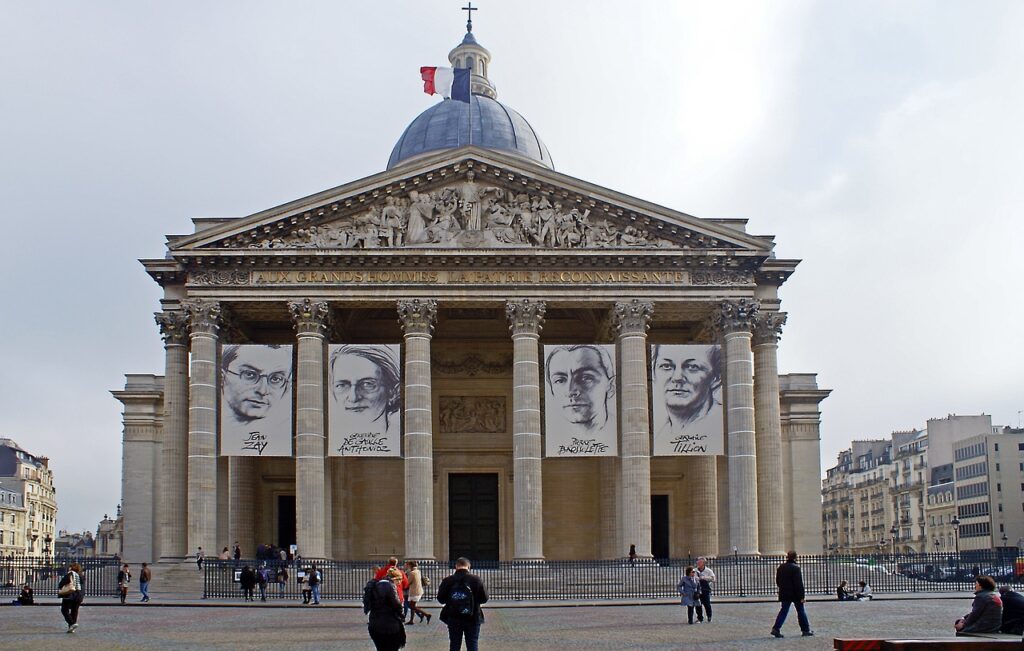In the 5th arrondissement of Paris, perched atop Montagne Sainte-Geneviève, the Panthéon stands high above the Latin Quarter. It casts an impressive shadow over its neighbours and the thousands of students who attend the many schools and universities in this district, and it is a prominent feature of the Parisian skyline. The Panthéon’s facade, modelled after its namesake in Rome, is inscribed with the words, “Aux grands hommes, la patrie reconnaissante (To the great men, the grateful homeland). Inside, you will find the final resting place of some of France’s greatest citizens, including Victor Hugo, Voltaire, Rousseau, Marie Curie, Louis Braille, Alexandre Dumas, and Simone Veil, making the Panthéon one of the most famous mausoleums in the city.
I recently paid a visit to the Panthéon and the many French heroes buried within, and it was a wonderful reminder of just how many incredible thinkers, artists, and scientists France has produced over the centuries. I also took the opportunity to climb to the dome that sits in the centre of this magnificent building, and let me tell you, the view from the top is spectacular. Considering the Panthéon’s location in Paris and the many prominent people you can find inside, it’s no surprise that this building holds many stories worth discovering. Today, I’m going to share with you one of my favourites.
The Story Begins…
Construction began on the Panthéon in 1758 under the orders of King Louis XV, and under the supervision of designer Jacques-Germain Soufflot. The new building was intended to be a majestic church dedicated to St. Geneviève, one of the patron saints of Paris. However, work on the Panthéon progressed slowly, and neither Louis nor Soufflot lived to see its completion. The building wasn’t finished until 1790, which just so happened to be less than a year after the French Revolution began with the storming of the Bastille on July 14th, 1789. Churches were no longer welcome in revolutionary Paris, and therefore the newly formed National Constituent Assembly declared that the Panthéon would be used as a mausoleum for France’s national heroes instead. On April 4th, 1791, Honoré Gabriel Riqueti, comte de Mirabeau, was given the honour of being the first Frenchman to be laid to rest within its walls. While it was indeed a great honour, it was far from the end of the story for Mirabeau and the Panthéon.
The Honoré Gabriel Riqueti, comte de Mirabeau, the Panthéon’s First Hero
 Born into the French nobility in 1749, Mirabeau came to prominence during the early stages of the French Revolution due to his exceptional oratory skills. The revolution was actually a godsend to his reputation, because prior to 1789 he had lived his life in varying states of scandal. His many exploits included manipulating a young heiress into marriage, generating large amounts of debt due to his extravagant lifestyle, being sentenced to death for the seduction and abduction of another man’s wife, moonlighting as an erotic writer while in prison, and at one point being stripped of his nobility. Things got so bad that his own father had Mirabeau imprisoned in order to save him from his many creditors. When the French Revolution began in 1789, Mirabeau’s finances and reputation were in tatters, but he quickly saw the burgeoning uprising as an opportunity to improve his station in life.
Born into the French nobility in 1749, Mirabeau came to prominence during the early stages of the French Revolution due to his exceptional oratory skills. The revolution was actually a godsend to his reputation, because prior to 1789 he had lived his life in varying states of scandal. His many exploits included manipulating a young heiress into marriage, generating large amounts of debt due to his extravagant lifestyle, being sentenced to death for the seduction and abduction of another man’s wife, moonlighting as an erotic writer while in prison, and at one point being stripped of his nobility. Things got so bad that his own father had Mirabeau imprisoned in order to save him from his many creditors. When the French Revolution began in 1789, Mirabeau’s finances and reputation were in tatters, but he quickly saw the burgeoning uprising as an opportunity to improve his station in life.
From 1789-1791, Mirabeau gave several speeches that electrified the people of Paris. He championed representational government and a system of constitutional monarchy, but maintained that the King should retain an absolute veto. His moderate positions ultimately proved extremely popular with the masses, and when he died on April 2nd, 1791, the people of Paris did not hold back in their grief. It has been suggested that the Panthéon was turned into a mausoleum specifically for him. Mirabeau was interred there on April 4th, 1791, and he was posthumously hailed as one of the fathers of the French Revolution.
The Honoré Gabriel Riqueti, comte de Mirabeau, the Panthéon’s First Traitor
In 1792, papers were discovered that revealed that Mirabeau had been in collusion with the deposed King Louis XVI and Queen Marie Antoinette. Later, additional documents revealed that these dealings had been tailored not to benefit France, but Austria, the homeland of France’s most hated queen. His reputation once again in tatters, Mirabeau’s remains were removed from the Panthéon on September 21st, 1794, and reburied in an unmarked grave. To this day they have never been found.
The Panthéon Today
 Throughout its existence, the Panthéon has switched between being a church and a mausoleum several times to reflect the changing of the tide of the French Revolution. However, in the end, its position as a mausoleum won out, and today it stands as a monument to the legacies of France’s greatest men and women. Interment is only permitted through a parliamentary act, and those who are laid to rest within its walls are considered some of the greatest French men and women of all time.
Throughout its existence, the Panthéon has switched between being a church and a mausoleum several times to reflect the changing of the tide of the French Revolution. However, in the end, its position as a mausoleum won out, and today it stands as a monument to the legacies of France’s greatest men and women. Interment is only permitted through a parliamentary act, and those who are laid to rest within its walls are considered some of the greatest French men and women of all time.
The Pantheon is open seven days a week* and there is much more to see than just the tombs of France’s heroes. In 1851, the physicist Leon Foucault hung a pendulum from the central dome as part of an experiment to reveal evidence of the earth’s rotation, and a replica of this pendulum still hangs inside today. The architecture and artwork on display are stunning, and as previously mentioned, the view from the dome is well worth the climb. The next time you find yourself in the Latin Quarter, be sure to leave time for a visit to this incredible building. Information on opening hours and tickets can be found HERE.
*except January 1, May 1, and December 25




